
It was not lost on the sizable crowd gathered at FCCJ for a sneak preview of Fukushima 50 that they were in the midst of one disaster (COVID-19) while watching another unfold onscreen.
Many of them had been in Japan on March 11, 2011 and had covered its aftermath. Some had even been able to speak directly with the engineers, technicians, firefighters, soldiers and other staff who stayed at the Fukushima Daiichi Nuclear Power Plant after the earthquake and tsunami had laid siege, risking their lives in a desperate 5-day struggle to prevent a total meltdown of the overheating atomic reactors and to minimize the (literal) fallout from the world's worst nuclear accident since Chernobyl.
Dubbed the “Fukushima 50” by the international press (but actually numbering in the hundreds), few of these brave workers — whether for fear of ostracism or reprisal — spoke on the record. But journalist Ryusho Kadota managed to interview over 90 of them, and their testimony was compiled in his 2012 nonfiction book, “On the Brink: The Inside Story of Fukushima Daiichi” (republished by Kadokawa Publishing in 2016).
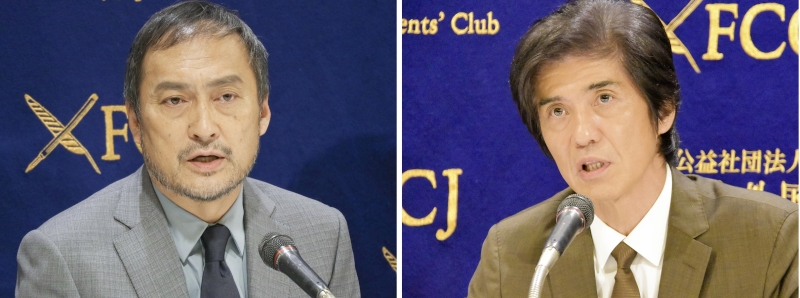
©Koichi Mori
That book now forms the backbone of the powerful, poignant Fukushima 50, the first film that depicts the tragedy head-on and in minute detail. While fact-checkers are already sharpening their pens, there is no doubt that its nationwide release, just days before the 9th anniversary of the triple disasters, will open up an expanded public dialogue.
Appearing at the Q&A session following the screening, fabled stars Ken Watanabe and Koichi Sato discussed the timing of the release, their hopes for its impact and their own working relationship.
“When we’re in the throes of a national crisis like this,” Watanabe told the audience, “I think films, or at least this film, can give us an opportunity to reflect on ourselves, to reflect about the choices we’re making and which direction we should be heading in. I hope Fukushima 50 will provide an important opportunity to step forward into the future.”
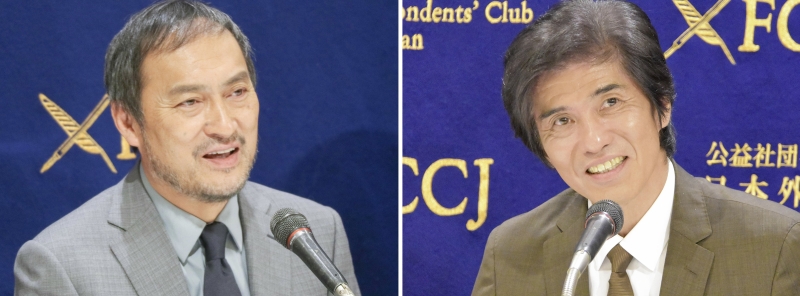
©Koichi Mori ©FCCJ
Recalled Sato, “When they first approached me with this project, I was wary. I thought it might be a little premature to come out with a film about Fukushima. It wasn’t long after the accident and there were still a lot of victims suffering from the experience. But after completing the film, we shared it with audiences in Fukushima. They understood there would be traumatic scenes, but they stayed until the end and thanked [director Setsuro] Wakamatsu for making it.
“So I went from thinking the film was premature to thinking that we’d made it just in time. It’s necessary for painful memories to fade, so that people can move forward. But you don’t want the memories to fade completely. Fukushima 50 creates an opportunity for us to reflect on the accident and in that sense, the timing is just right.”
The actors were flanked by their director, and by the chairman of Kadokawa Corporation, Tsuguhiko Kadokawa, who greenlit the project and served as its supervising producer. “I’d wanted to make a film based on the events of March 11 early on,” he told the crowd. “I had privately invested in a planned production with [late actor-director] Masahiko Tsugawa. But it was difficult [to move forward]. Then I read ‘On the Brink,’ and it pulled me back on track. We are approaching the ‘Reconstruction’ Olympics and Paralympic Games this year, and I wanted to complete it in time for that.”
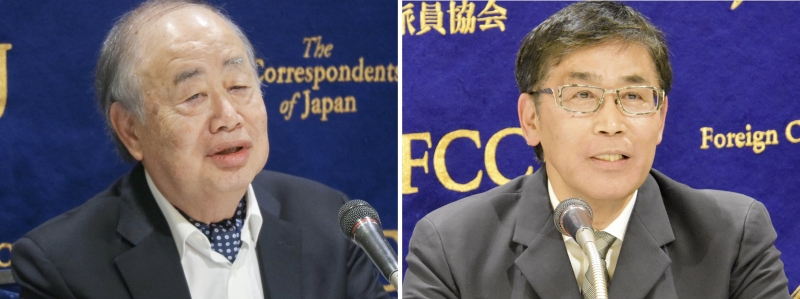
Supervising producer Kadokawa (left) and director Wakamatsu. ©Koichi Mori, ©FCCJ
As for Wakamatsu, “What attracted me to this story was that it depicts all the strengths and all the weaknesses of human beings. There were all these workers who had to summon up the courage to volunteer to go into the reactor building. There are so many layers of vulnerability but also courage in these characters, and that’s why I was attracted to directing the film.
“Every year at this time, 3/11 has dominated the TV news, especially NHK. But I feel there has been less TV coverage recently, and I hope Fukushima 50 can be shown each year to encourage us to reflect on the pros and cons of nuclear power, among other issues.”
Wakamatsu’s film feels as tense as if it were unfolding in real time. Shot in sequence on a big open set in Suwa, Nagano, with 2,000 extras and some convincing computer graphics, it thrusts viewers straight into the harrowing eye of the developing disaster, and into the decision-making processes of the two men closest to the crisis, Toshio Izaki (Koichi Sato), chief of Fukushima Daiichi Nuclear Power Plant Units 1 and 2, and Plant Director Masao Yoshida (Ken Watanabe).
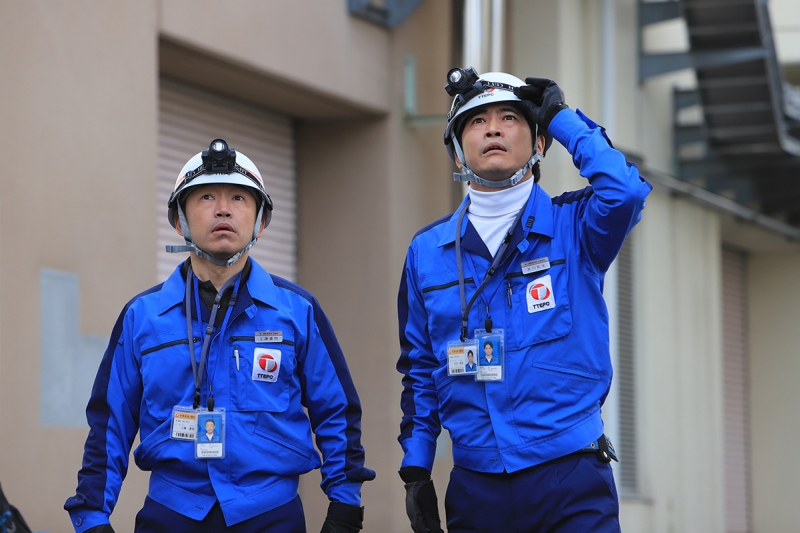
Daiichi plant workers react to the approaching tsunami. © 2020 “Fukushima 50” Film Partners
Fukushima 50 begins precisely at 2:46 pm on March 11, as the magnitude 9 earthquake strikes off the coast of Tohoku, triggering immediate reverberations at the plant. As workers stream from buildings, Izaki and his crew try to determine what damage has been done, and where. His longtime colleague, Yoshida, assesses the situation from his office in another part of the plant, and communicates via videocam with Tokyo Electric Power Company (Tepco) headquarters.
But the quake has triggered a “mega-tsunami” with waves that will soon pour over a 40-meter-high seawall, engulfing the plant. Just 54 minutes after the temblor, Fukushima Daiichi experiences a station blackout, halting cooling systems and leading the reactors and spent fuel-rod assemblies to begin to overheat. Despite the remaining staff’s valiant efforts to keep equipment running with car batteries, the plant is soon running nearly manually, and technicians must risk radiation exposure to open valves the dangerous, old-fashioned way — wearing Hazmats and gas masks in utter darkness.
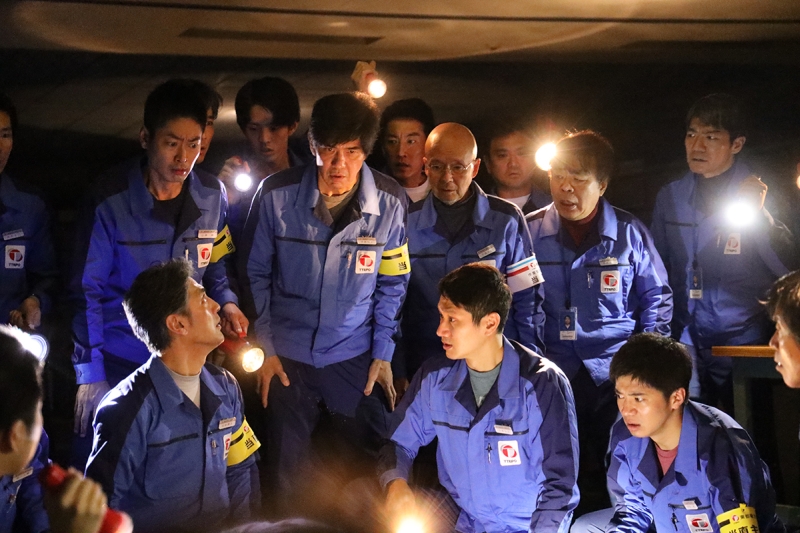
Izaki rallies his crew to assess the damage. © 2020 “Fukushima 50” Film Partners
Working frantically to solve each fresh catastrophe as it emerges, and inspiring their workers by their own examples, Izaki and Yoshida confront the unprecedented crisis with tireless ingenuity and an occasional outburst that is fully earned. At one point, Yoshida drops his pants and moons his Tepco bosses in Tokyo. Eventually, his defiance of orders will help avert a disaster of global magnitude.
In a film that is as harrowing as it is moving, Sato and Watanabe shine. But their characters aren’t the only samurai at the plant; all the workers who stayed behind know they’re risking their lives, and Fukushima 50 celebrates their selfless sacrifices by depicting them in strength and weakness, in bravado and in teary-eyed relief.
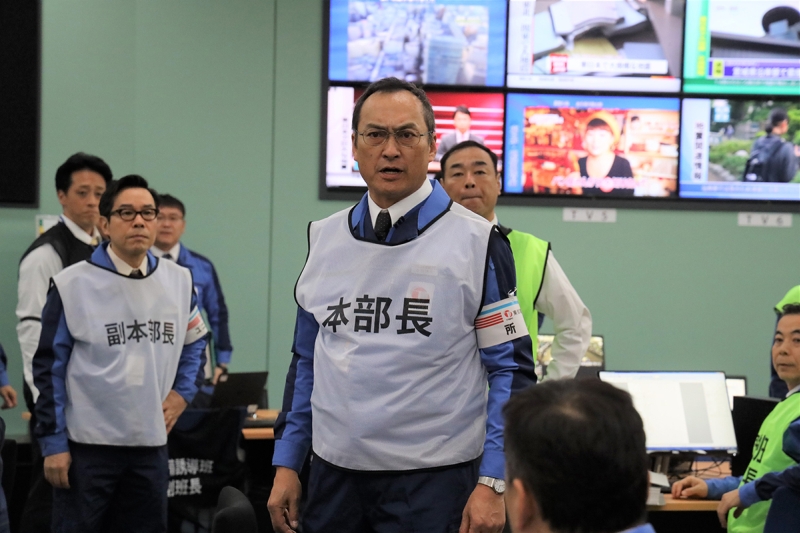
Yoshida barks orders in the control center. © 2020 “Fukushima 50” Film Partners
The film provided the first opportunity in 7 years for Sato and Watanabe to act together (since Li Sang-il’s Unforgiven), and they were asked how it felt to be in the same film but almost never on the same set.
“There’s just one scene in which you see us together, and that’s in the toilet,” cracked Sato. After the laughter died down, he continued, “We shared many tense moments over that emergency red phone, and we gave a lot of thought about how we could convey the intensity of [those phone calls].
“We’ve both been working in the film industry for 40 years. There were many missed opportunities when we could have worked together. So it was a big moment when we could finally do Unforgiven together, and we managed to establish a relationship built on trust.”
Watanabe nodded. “It was definitely a challenging experience shooting Unforgiven, and we established a solid friendship. I remember Mr. Sato was approaching his 100th film at the time, and I told him I would work on his 100th even if it meant being a passerby in the background. But he made so many films so quickly, it just didn’t happen.
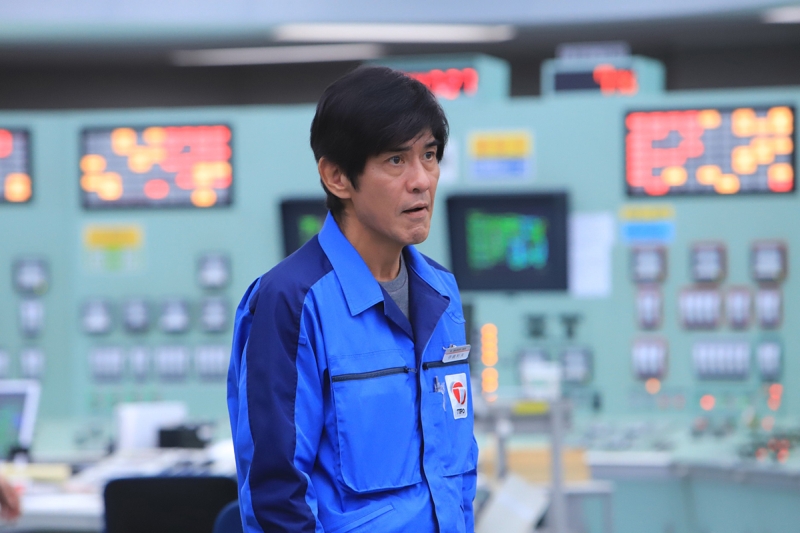
Izaki before all hell breaks loose. © 2020 “Fukushima 50” Film Partners
“I’d actually received a few offers to play the plant director in other films before this one, but I’d felt it wouldn’t be enough to just depict Mr. Yoshida’s story. Then I read the script for Fukushima 50, which focuses on the character of Mr. Izaki, who grew up alongside the Fukushima Daiichi plant. When I saw how it was structured, I realized how dramatic the film could be. When I heard that Mr. Sato had been cast in the role, I immediately said I wanted to be part of it. I have complete trust in him as an actor.”
Asked how he had prepared for his role as Yoshida, who died in 2013, Watanabe answered, “Mr. Yoshida is the only character who goes by his actual name; the other characters have all been given new names. He was heavily covered by the media during and after 3/11, so I think that a lot of people remember seeing him. I knew it would be futile to simply mimic him, so I researched his background, his education, his career. But the most helpful thing for me was hearing from people who worked with him. They talked about how he responded to the accident, especially how he negotiated with the people at Tepco, in the government and how he tried to defuse the tension in the control center.”
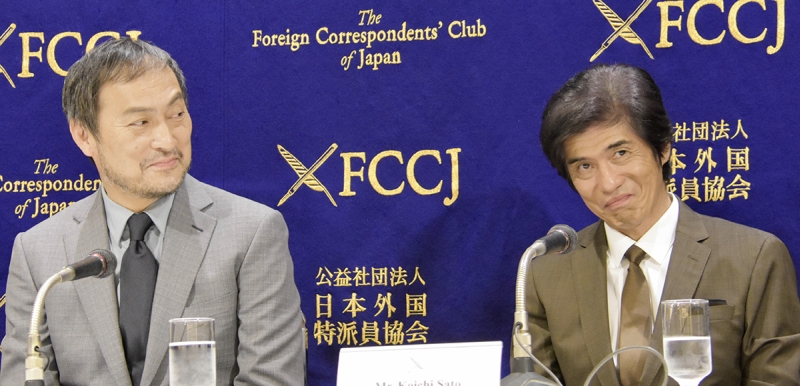
©FCCJ
Thanking the team for a “challenging film,” one journalist asked the question on everyone’s mind: had they experienced any interference from either the government or from Tepco in making the film?
“We anticipated that we would get a question like this,” responded Kadokawa. “For 30 years, Kadokawa has been making films about social issues, like Jubaku: Spellbound, about (corruption in) the banking industry, and The Unbroken, starring Mr. Watanabe, which depicted an airline company (after the horrific crash of a jumbo jet, based on JAL 123). Many film companies avoid making such films in this era of sontaku (sucking up to the powers that be), in deference to certain parties or people.
“But it wasn’t our intention to make a film [condemning] a public utility, per se. The core message of Fukushima 50 is that we cannot conquer nature. As Mr. Watanabe’s character says in the film, human ego has made us disrespect nature. If the audience can take that message away with them, I would be very happy.”
Wakamatsu elucidated, “We didn’t hear any direct comments from the government. Maybe something was said behind closed doors, but we have no way of knowing. Personally, I received no pressure at all from the government. In fact, the Reconstruction Agency and the current prime minister were involved, and our former prime minister (Naoto Kan, who is depicted in the film), saw the film and I haven’t received any complaints from him. So I suppose there’s no problem.”
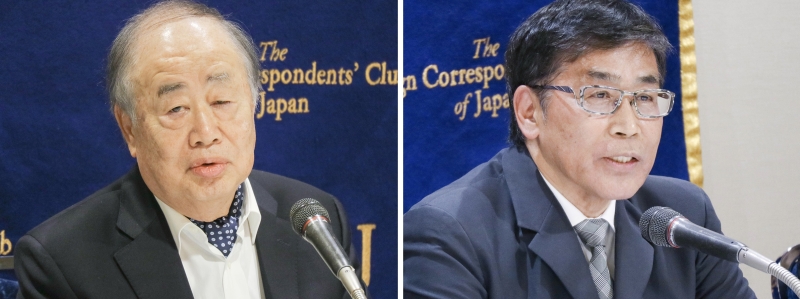
©Koichi Mori
Martin Fackler, Tokyo bureau chief of The New York Times in 2011 and the first foreign reporter to enter the Fukushima Daiichi plant after the disaster (his team’s coverage would later result in a shortlisting for the Pulitzer Prize), was one of the many FCCJ members in the audience who had firsthand knowledge of the events depicted in the film. Addressing Kadokawa, he said, “There are many versions of what happened in Fukushima, and the one you chose, by Kadota, is fairly positive. There are others that are more negative, and Yoshida left us his own version in the ‘Yoshida Chosho.’ Why did you choose the Kadota version?”
Responded Kadokawa, “It wasn’t until I read Mr. Kadota’s book that I realized there was a way we could actually tell the story. I felt that adapting his book would also allow me to realize Mr. Tsugawa’s dream. When you’re grappling with a theme like this, you have 100 people involved in the project and 100 different opinions. All we could do was stay true to the facts.
“It’s become increasingly complicated for the media to cover these issues, and we’re approaching a dangerous juncture when it comes to reporting through the media. In such an [environment], I think film may be a better medium for conveying the truth. Being a publisher myself, I still have this sense of respect and awe toward the medium that is film. I approached the project with the conviction that we were going to depict the facts, and I think we were able to do this.”
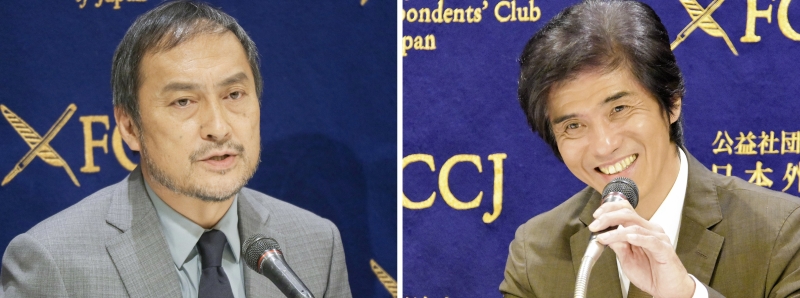
©Koichi Mori ©FCCJ
For his part, Wakamatsu was “quite confident that we could make an effective film that wasn’t just a chronological record of what happened, but was about the men who had to fight on the site. I felt it was an opportune moment to show the world what the Fukushima 50 were made of.
“I imagine that if the international media were asked what they would have done in that situation, face to face with death, many would answer that they would have fled. I suppose you could say that this sense of self-sacrifice or ‘Yamato spirit’ is a Japanese trait. It’s something that resonates throughout the film, and I wanted to share it with audiences.”
(There was no time to draw comparisons to first responders around the globe, who constantly put their lives on the line to ensure the safety and welfare of the community at large.)
But Fukushima 50 has already been sold to 73 international territories, demonstrating the universality of its remarkable story and the strength of its telling — so the dialogue about manmade disasters and the human toll is sure to expand.
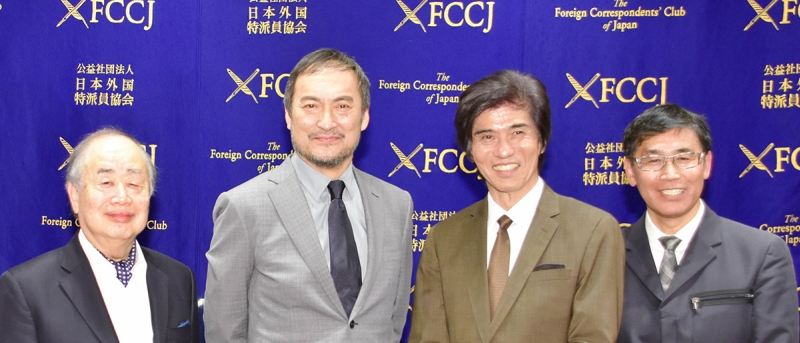
©FCCJ
“I have a lot of friends living overseas,” noted Watanabe, “and I have the sense that the word ‘Fukushima’ has a very negative connotation. When we hear ‘Fukushima,’ it’s all about how Japan is still trying to come to grips with 3/11. We experienced Hiroshima and Nagasaki seven decades ago, and we’ve finally reached a point at which ‘Hiroshima’ and ‘Nagasaki’ have become words that prompt us to think about nuclear arms. They’ve become symbols of peace. In the same way, I hope that ‘Fukushima’ will prompt us to think about nuclear power, and that someday, the word has a positive connotation.”
His costar concurred. “A disaster like this is bound to leave a negative legacy,” said Sato. “But I think it’s very important to tell the story in an accurate way, and in the spirit of sublimating what happened so that we can leave a positive legacy for the next generation — as we were able to do with Hiroshima and Nagasaki. I hope Fukushima 50 leaves audiences with that kind of sentiment.”
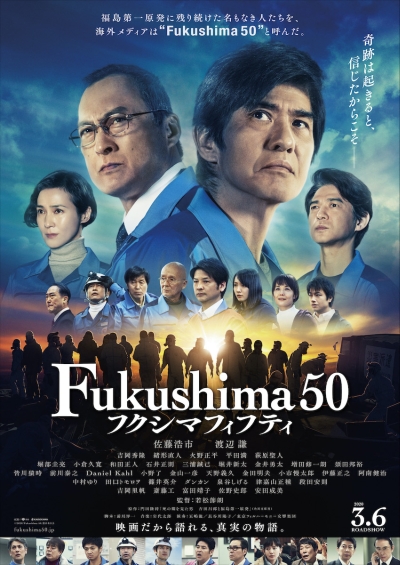
© 2020 “Fukushima 50” Film Partners
Selected Media Exposure
- 佐藤浩市と渡辺謙、「Fukushima 50」に込めた思いを海外メディアに熱弁
- Dramatizing the reality of a nuclear meltdown
- 渡辺謙、佐藤浩市に英語でツッコミ!?映画『Fukushima 50』(フクシマフィフティ)日本外国特派員協会 記者会見
- 佐藤浩市、『Fukushima 50』の製作は「風化させないためにも、ギリギリのタイミングだった」
- <Fukushima50>公開はなぜ今? 佐藤浩市「風化しちゃいけない、痛みを語り継ぐため…」
- 渡辺謙が「Fukushima 50」に出演した理由とは?佐藤浩市は心境の変化明かす
- 佐藤浩市、3・11題材作に葛藤「映画化は早いのでは…」 若松監督は“圧力”否定
- 渡辺謙語った「国難の岐路に立たされた時ヒントに」
- 渡辺謙、映画「Fukushima50」は「国難の岐路に何をすべきかヒントになる」
- 渡辺謙、コロナ拡大「国難の岐路…何をすべきかヒントになる映画」
- 「Fukushima50」原案は故・津川雅彦氏だった
- 「Fukushima50」5日公開 佐藤浩市「このタイミングで見てもらうことに意味がある」
- 渡辺謙「Fukushimaをポジティブなワードに」佐藤浩市と世界にアピール
- 佐藤浩市と渡辺謙『絶対の信頼関係』語った!大半は電話で話すシーンでも「つながっていた」
- 「Fukushima50」5日公開 佐藤浩市「このタイミングで見てもらうことに意味がある
- 「フクシマ50」全国公開をPR 佐藤浩市さんら
- 佐藤浩市、主演作に葛藤 原発事故の映画化は「まだ早いと思った」
- 渡辺謙「出るべき作品」佐藤浩市に全幅の信頼
Selected TV Exposure
日本テレビ【Oha!4 佐藤&渡辺】映画に込めた思い ”未来に向かうステップになる”
日本テレビ【ZIP!】渡辺謙のメッセージ 国難乗り越えるヒント
TBS【はやドキ!】佐藤浩市&渡辺謙 絶対の信頼関係
フジテレビ【めざましテレビ】佐藤浩市 映画化に葛藤
MX【モーニングCROSS】佐藤浩市×渡辺謙『絶対の信頼関係』語る
Read more
Published in: March
Tag: Ken Watanabe, Koichi Sato, Setsuro Wakamatsu, Tsuguhiko Kadokawa, Fukushima, nuclear power, 3/11, Tepco
Comments

